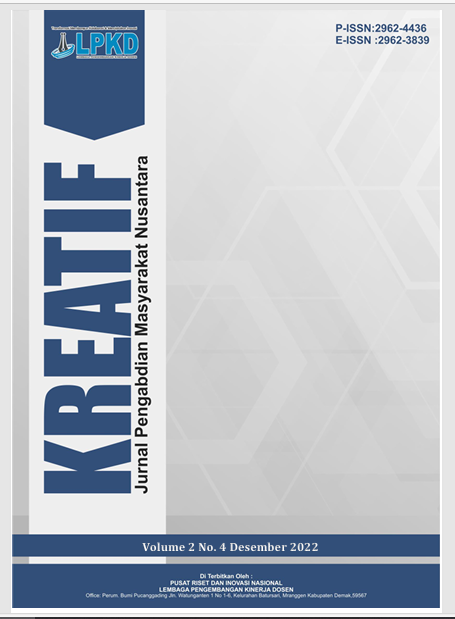Konsep Smart Goal Setting Pada Bisnis M-Prod Demi Meningkatkan Bisnis Songket di Kota Palembang
DOI:
https://doi.org/10.55606/kreatif.v2i4.2234Keywords:
Smart Goal Setting, M-Proud, Songket BusinessAbstract
Palembang City has one type of industry that produces typical South Sumatran products, namely songket weaving with different characteristics from songket weaving in other provinces. Ogan Ilir Regency is a songket producing center that has been formed for quite a long time and the largest songket craftsman center in South Sumatra Province. This study aims to determine the economic empowerment strategy of songket craftsmen typical of Palembang City by the Department of Industry, Trade, Cooperatives and MSMEs of Palembang City. The subjects of the study were songket craftsmen, songket sellers and apparatus at the Department of Industry, Trade, Cooperatives and MSMEs of Palembang City. The results of this study show that the economic empowerment strategy of songket craftsmen typical of Palembang City by the Department of Industry, Trade, Cooperatives and MSMEs of Palembang City that can be used, namely intensive strategies with market penetration, market development, product development or integration with various existing opportunities. The MSME policy made has not been able to overcome various problems that occur in songket craftsmen.
References
Ananda, A. D., & Susilowati, D. (2017). Pengembangan usaha mikro kecil dan menengah (umkm) berbasis industri kreatif di kota malang. Jurnal Ilmu Ekonomi JIE, 1(1), 120–142.
Cunningham, S. (2004). The creative industries after cultural policy: A genealogy and some possible preferred futures. International Journal of Cultural Studies, 7(1), 105–115. https://doi.org/10.1177/1367877904040924
Doringin, F., Tarigan, N. M., & Prihanto, J. N. (2020). Eksistensi Pendidikan Di Era Revolusi Industri 4.0. Jurnal Teknologi Industri Dan Rekayasa (JTIR), 1(1), 43–48. https://doi.org/10.53091/jtir.v1i1.17
Fitri, F. (2020). Pelatihan Menjahit dalam Meningkatkan Jiwa Kewirausahaan Perempuan di Pusat Kegiatan Belajar Masyarakat (PKBM) Tiara Dezzy Samarinda. Jurnal Bosaparis: Pendidikan Kesejahteraan Keluarga, 11(2), 27–34.
Flew, T. (2005). Creative Commons and the creative industries. Media and Arts Law Review, 10(4), 257–264.
Levickaitė, R. (2011). Four approaches to the creative economy: general overview. Business, Management and Education, 9(1), 81–92.
Peters, M. A., & Besley, T. (A. C. . (2008). Academic Entrepreneurship and the Creative Economy. Thesis Eleven, 94(1), 88–105. https://doi.org/10.1177/0725513608093278
Purwanto, M. B. (2021). Makanan Khas Jawa (Bebek Goreng) Sebagai Salah Satu Daya Tarik Wisata Kuliner Di Kota Palembang Pada Rm Bebek Gendut. JURNAL PARIWISATA DARUSSALAM, 1(1), 22–28.
Purwanto, M. B. (2022). Pengembangan Kain Khas Kabupaten Musi Banyuasin Sebagai Upaya Untuk Meningkatkan Ekonomi Lokal. JURNAL PARIWISATA DARUSSALAM, 1(2).
Sung, T. K. (2015). The creative economy in global competition. In Technological Forecasting and Social Change (Vol. 96, pp. 89–91). Elsevier. https://doi.org/10.1016/j.techfore.2015.04.003
Susanto, Y., Effendi, M., & Purwanto, M. B. (2022). Sosialisasi Penggunaan Literasi Digital Dalam Memasarkan Produk Ukm Di Desa Semangus Kecamatan Muara Lakitan Kabupaten Musirawas. Abdimas Galuh, 4(2), 1408–1415. http://dx.doi.org/10.25157/ag.v4i2.8612
Downloads
Published
How to Cite
Issue
Section
License
Copyright (c) 2022 Fitria Marisya

This work is licensed under a Creative Commons Attribution-ShareAlike 4.0 International License.








